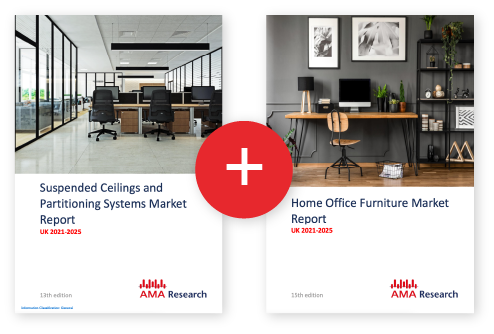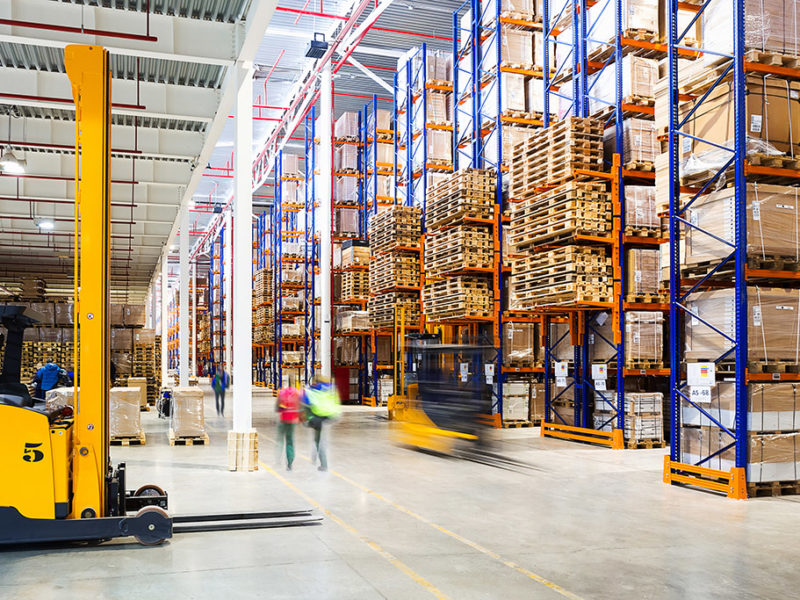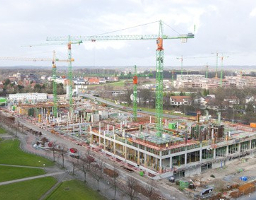Warehouse & Storage Construction Market Report – UK 2019-2023
Available as an Instant Download PDF
The 3rd edition of the ‘Warehouse & Storage Construction Market Report Market Report – UK 2019-2023’ has been published by AMA Research. The report should be of particular interest to developers, occupiers, logistics companies and construction professionals and provides a comprehensive review of the warehouse property sector.
£1,599.00 Exc. VAT
The 3rd edition of the ‘Warehouse & Storage Construction Market Report – UK 2019-2023‘ has been published by AMA Research. The report should be of particular interest to developers, occupiers, logistics companies and construction professionals and provides a comprehensive review of the warehouse property sector.
Key areas in the report:
- An overall review of the UK warehouse sector with estimated forecasts for growth to 2023.
- Detailed review of the regional warehouse market in terms of take-up and demand, availability and supply, rental levels, occupier trends, key clusters of warehouse demand and pipeline development.
- Over last few years, there has been a shift towards more regional sourcing of warehouse development.
- A review of warehouse occupiers by end sector with the retail/e-retail, logistics and 3PL sectors continuing to drive demand.
- Detailed assessment of warehouse construction output, new orders and contract activity together with growth forecasts over the next few years to 2023.
Areas of particular interest:
- Analysis of the national and regional warehouse development pipeline with schemes currently under construction and those expected to complete before 2023.
- Focus on the impact of structural changes to the retail sector, in particular, the rise in e-commerce and its impact on distribution networks, with a particular focus on the growing importance of regional locations or ‘hubs’ to fulfil last mile deliveries.
- The Report also considers the key drivers of demand for warehouse space and the main challenges facing the sector including key economic indicators; an analysis of retail sales and consumer spending; sustainability issues in the design and construction of warehouses; land shortages and planning delays.
- Analysis of the ongoing impact of Brexit on warehouse demand, including an increase in short-term demand from retailers and manufacturing supply chain tenants for additional warehousing space in the event of a no-deal Brexit; and the rise in demand for specialist types of warehousing space, such as bonded warehouses and cold storages close to UK ports and airports.
- Analysis of warehouse procurement, including a return to speculative development, which has been concentrated in the Midlands, London/South East and the North West. Analysis of the speculative development pipeline to 2023.
- Outlook for warehouse demand and development activity in 2019 and beyond and an overall analysis of the current marketplace with indications of potential future trends and opportunities for growth.
- Key construction contractors, investors and developers operating in the logistics and warehouse sector – contractor profiles, recent contracts awarded, etc.
- Review of major contract awards in the warehouse sector during 2018. Analysis by value of contract and approximate share by contractor.
- Detailed market data and insight on the warehousing construction market by AMA Research, a leading UK provider of construction market intelligence.
Construction Output in the Warehouse Sector
- Overall Construction Output – Total Construction Output to 2023; Construction Output by Sector.
- Value of Construction Output and New Orders in the Warehousing Sector.o Market Prospects for Warehousing Construction Output.
- Overview of the UK Warehouse Development Pipeline.
- Analysis of the Speculative Development Pipeline to 2023.
- Warehouse Contracts – Analysis of warehouse contracts at all stages of the construction pipeline; contracts awarded by Region in 2018.
- Regional Warehouse Sector – Regional Warehousing Clusters and Areas of Sector Demand.
- Regional Warehouse Activity and Development Pipeline – London and the South East; East Midlands; West Midlands; North West; Yorkshire & Humber; North East; South West; Scotland.
Factors Influencing the Warehousing Sector
- Manufacturing Output Levels.
- Retail Sales & Consumer Spending – Structure of the Retail Market; Key Growth Areas in the Retail Market; Retail Administrations & CVAs; Impact on the Warehousing Sector.
- E-Commerce and Warehousing – Growth & Evolvement of Online Retail; Impact of E-Commerce on Warehouse Demand and Requirements.
- Impact of Brexit on the Warehousing Market.
- Environment Drivers – Sustainability in Wareouse Design.
- Land and Planning Issues – Business & Empty Rates Relief.
The Warehousing Sector in te UK
- Warehouse Occupiers by End Sector.o Analysis of the Retail Warehousing Sector.
- Warehouse Take-up Levels.o Warehouse Availability and Vacancy Rates/Rental Levels.
- Distribution of Freight.
- Outlook for the Warehousing Sector.
Construction Market Supply in the Warehouse Sector
- Procurement of Work in the Warehousing Sector – Procurement Routes used in the Warehousing Sector.
- Key Contractors in the Warehousing Sector – Contractor’s Market Share in the Warehousing Sector – By Contract Awards.
- Detailed Contractor Profiles – A&H Construction; Benniman; Buckingham Group; Clugston; Kier; McLaren Construction; Readie Construction; Russells Construction; Volker Fitzpatrick; Winvic.
- Other Contractor Profiles – Barnfield; Bowmer & Kirkland; Bridgford Interiors; Caddick Construction; Chalcroft; GMI Construction; Harmonix; Howard Russell; ISG; Marshall Construction; MCS Group; Mitchell Design & Construction; Morrison Construction; Pochin PLC; and Stepnell.
- Warehouse Developer & Investor Profiles – Barberry; Bericote; DB Symmetry; Gazeley; Goodman; IM Properties; Panattoni; ProLogis; Roxhill; SEGRO; St. Modwen; and Tritax Big Box.
After years of decline, confidence has returned to the warehouse sector, which is set to become a long-term growth area, driven by a change in consumer habits and the structural shift in consumer spending to online.
As such, the increase in the number of distribution centres being built to meet the demands of online shoppers is set to continue, as is the conversion of existing warehouse space to meet demand.
Improving consumer confidence, a stronger economy and the continued demand for space from the e-commerce sector has seen total demand for warehousing floor-space across all regions improve with take-up rising.
With tight supply now a key characteristic of the UK warehouse market, developers have begun to address the lack of existing supply and the overall level of speculative development has increased in 2018, with the bulk of activity concentrated in the Midlands, London/South East and the North West.
Key drivers ought to be continuing growth in demand among online retailers and 3rd party logistics companies and parcel carriers and their requirement for new distribution centres to service the expansion in online shopping.
In the short-term, demand may probably increase among manufacturers for additional warehousing space close to factories in the event of a no-deal ‘Brexit’, particularly for perishable goods as demand food suppliers seek to stockpile supplies ahead of the UK’s departure from the EU.
- Contents Listing
- 1. INTRODUCTION 7
- 1.1 INTRODUCTION 7
- 1.2 SOURCES OF INFORMATION 7
- 2. SUMMARY 9
- 2.1 RECENT TRENDS AND DEVELOPMENTS 9
- 2.2 MARKET PROSPECTS 10
- 2.3 OCCUPIER DEMAND 11
- 2.4 THE REGIONS 11
- 2.5 PROCUREMENT AND SUPPLY 12
- 3. ECONOMIC ENVIRONMENT 13
- 3.1 OVERVIEW AND OUTLOOK 13
- 3.2 KEY DATA 14
- 3.2.1 GDP 14
- 3.2.2 Inflation & Interest Rates 14
- 3.2.3 Employment & Wages 15
- 3.2.4 Household Consumption 16
- 3.2.5 Sterling 17
- 4 WAREHOUSING & STORAGE IN THE UK 18
- 4.1 DEFINITION 18
- 4.2 OVERVIEW 18
- 4.3 EXPANSION OF ON-LINE RETAILING 19
- 4.4 WAREHOUSE TAKE-UP LEVELS 20
- 4.5 RENTAL LEVELS 22
- 4.6 DISTRIBUTION OF FREIGHT 22
- 4.7 OUTLOOK FOR THE WAREHOUSING SECTOR 24
- 5. CONSTRUCTION OUTPUT IN THE WAREHOUSE SECTOR 26
- 5.1 OVERVIEW 26
- 5.2. MARKET SIZE AND TRENDS 26
- 5.3 MARKET PROSPECTS 29
- 5.4 KEY MARKET DRIVERS 31
- 5.4.1 Availability of space 31
- 5.4.2 Manufacturing output levels 32
- 5.4.3 Impact of structural changes in retailing 33
- 5.4.4 Resumption in Speculative Development 35
- 5.4.5 UK’s departure from the EU 36
- 5.5 WAREHOUSING PROJECTS 37
- 5.5.1 By Type of Work 37
- 5.5.2 By Value 38
- 5.5.3 By Floor Area 38
- 6. REGIONAL ANALYSIS 40
- 6.1 OVERVIEW 40
- 6.2 LONDON AND THE SOUTH EAST 42
- 6.3 EAST MIDLANDS 43
- 6.4 WEST MIDLANDS 43
- 6.5 NORTH WEST 44
- 6.6 YORKSHIRE & HUMBER 45
- 6.7 NORTH EAST 45
- 6.8 SOUTH WEST ENGLAND AND SOUTH WALES 46
- 6.9 SCOTLAND 46
- 7. PROCUREMENT AND CONTRACTING 47
- 7.1 PROJECT PROCUREMENT ANALYSIS 47
- 7.1.1 Overview 47
- 7.1.2 Developer / User to Build 48
- 7.1.3 Traditional contract 49
- 7.1.4 Design & Build 49
- 7.1.5 Negotiated contracts 50
- 7.2 WAREHOUSE & STORAGE CONSTRUCTION MARKET SHARE 50
- 7.3 CONTRACTOR PROFILES 51
- 7.4 DEVELOPERS 54
- Tables & Charts
- CHART 1: WAREHOUSE COMPLETIONS BY TYPE (BUILD TO SUIT VS. SPECULATIVE) BY FLOOR AREA (MILLION SQ. FT.) 2009 – 2019 9
- CHART 2: WAREHOUSE CONSTRUCTION OUTPUT FORECAST (£M AT CURRENT PRICES) 2018 – 2023 10
- CHART 3: WAREHOUSE CONSTRUCTION PROCUREMENT BY ROUTE BY NUMBER OF PROJECTS 2017-2018 12
- TABLE 4: GDP DATA – 2015-2019 – KEY CONSTITUENT ELEMENTS 14
- CHART 5: INTEREST RATES AND INFLATION (CPI) FROM 2008-2023 15
- TABLE 6: AVERAGE WEEKLY EARNINGS DATA – GB – TOTAL PAY – 2014-2019 (SEASONALLY ADJUSTED) 16
- CHART 7: PDI & SAVINGS RATIO AT CURRENT PRICES 2008-2023 16
- TABLE 8: EXCHANGE RATE FLUCTUATIONS 2015-2021 – STERLING TO THE DOLLAR, AND THE EURO, SPOT RATES 17
- CHART 9: TAKE UP OF NEW WAREHOUSING SPACE BY END USE SECTOR 2018 18
- CHART 10: TAKE UP OF WAREHOUSE SPACE IN THE UK (M SQ. FT) 2014 – 2018 21
- TABLE 11: UK WAREHOUSING – RECENT MAJOR TAKE-UP TRANSACTIONS – CLIENT/LOCATION/FLOOR AREA 22
- CHART 12: DOMESTIC FREIGHT TRANSPORT BY MODE 2017 (%) 23
- CHART 13: INDUSTRIAL CONSTRUCTION OUTPUT (GB) BY SECTOR 2018 – % BY VALUE 26
- CHART 14: WAREHOUSE CONSTRUCTION – CONTRACTORS OUTPUT (£M AT CURRENT PRICES) 2014 – 2018 27
- CHART 15: WAREHOUSE COMPLETIONS BY TYPE (BUILD TO SUIT VS. SPECULATIVE) BY FLOOR AREA (MILLION SQ. FT.) 2009 – 2019 28
- CHART 16: WAREHOUSE CONTRACT AWARDS 2016-2018 BY VALUE (£M) AND NUMBER OF CONTRACTS 29
- CHART 17: WAREHOUSE CONSTRUCTION – CONTRACTORS OUTPUT FORECASTS (£M AT CURRENT PRICES) 2018 – 2023 30
- CHART 18: AVAILABILITY/SUPPLY OF WAREHOUSE SPACE IN THE UK (M SQ. FT) AND ANNUAL VACANCY RATE (%) 2009 – 2018 31
- TABLE 19: UK WAREHOUSE AVAILABILITY BY REGION – FLOOR SPACE (MILLION SQ. FT.) 2018 32
- CHART 20: ONLINE SALES REVENUES FOR E-TAILERS AND MULTI-CHANNEL RETAILERS: BY VALUE (£BN) 2014-2023 – 33
- TABLE 21: UK GROCERY MARKET SECTOR ANALYSIS (TURNOVER SIZE AND MARKET SHARE) BY VALUE (£BN) AND % – 2018 AND FORECAST 2023 34
- CHART 22: WAREHOUSE & STORAGE CONSTRUCTION – CONTRACTS AWARDED BY % OF AGGREGATE VALUE (BY % OF TOTAL NUMBER OF PROJECTS) BY WORK TYPE 2017-2018 37
- CHART 23: WAREHOUSE & STORAGE BUILDING PROJECTS BY PROJECT SIZE BAND (£M) BY NUMBER OF CONTRACTS AWARDED 2017-2018 38
- CHART 24: WAREHOUSE & STORAGE BUILDING PROJECTS BY FLOOR AREA SIZE BY NUMBER OF CONTRACTS AWARDED 2017-2018 38
- CHART 25: UK WAREHOUSE CONSTRUCTION CONTRACT AWARDS BY REGION 2018 (%) 40
- TABLE 26: UK WAREHOUSING – AVAILABILITY, SPACE TAKE-UP, SPACE UNDER CONSTRUCTION AND RENTAL VALUES 41
- CHART 27: ENGLAND: SPECULATIVE WAREHOUSE FLOOR-SPACE UNDER CONSTRUCTION BY REGION 2018 42
- CHART 28: WAREHOUSE CONSTRUCTION PROCUREMENT BY ROUTE BY NUMBER OF PROJECTS 2017-2018 47
- CHART 29: WAREHOUSE CONSTRUCTION PROCUREMENT BY ROUTE BY % OF TOTAL CONTRACT AWARD VALUES 2017-2018 48
- CHART 30: WAREHOUSING DEVELOPER TO BUILD CONTRACT AWARDS BY VALUE BY NUMBER OF PROJECTS 2017-2018 48
- CHART 31: TRADITIONAL CONTRACT AWARDS BY VALUE BY NUMBER OF PROJECTS 2017-2018 49
- CHART 32: WAREHOUSING DESIGN & BUILD CONTRACT AWARDS BY VALUE BY NUMBER OF PROJECTS 2017-2018 49
- CHART 33: WAREHOUSING NEGOTIATED CONTRACT AWARDS BY VALUE BY NUMBER OF PROJECTS 2017-2018 50
- CHART 34: WAREHOUSE CONSTRUCTION CONTRACT AWARDS – APPROXIMATE SHARE BY CONTRACTOR 2018 51

Paired Report Discount
Save £250 for every two reports you buy
Discount applied in basket
Frequently bought together

Trusted by industry leaders
For more detailed requests speak to our research experts directly
Research you can depend on
Our reports go deeper to give you the insights needed to make your next strategic move.
- Detailed assessment of the market – analysis of the market structure and recent developments within the market.
- Market prospects up to 4 years – market value, opportunities, impact of Covid-19, Brexit etc.
- Detailed information – market size, influences, market factors and key players.
- Analysis by product group – market size, product mix, sector trends etc.












